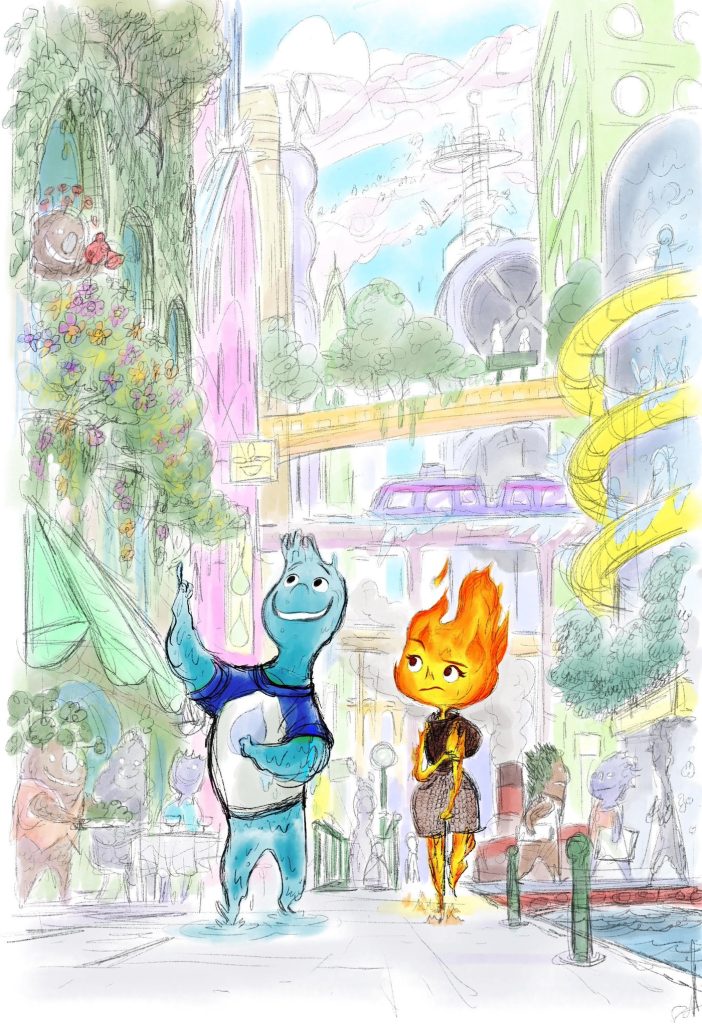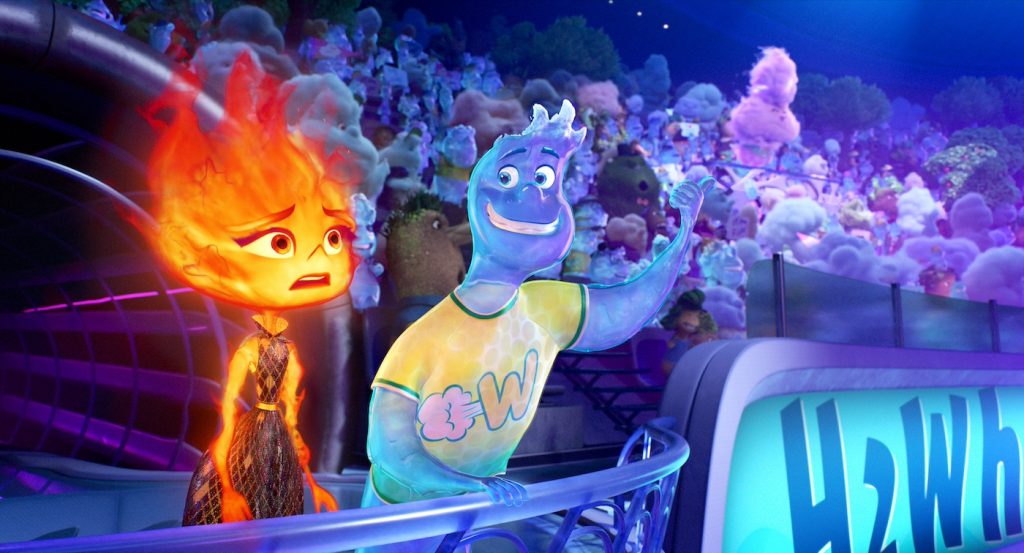
How do you make fire feel endearing rather than scary? And how do you turn water into a gusher of emotions? Those were key questions faced by director Peter Sohn when he set forth to make Elemental. The Bronx-born animator previously helped anthropomorphize rats, robots, dolphins, and dinosaurs in Ratatouille, Finding Nemo, WALL•E, and The Little Dinosaur. But never before had he tried to put a human face on earth, air, fire, and water. In directing his Oscar-nominated animated feature Elemental (now streaming on Disney +), Sohn created a fully enflamed hero fueled by the virtues and complexities expected from any big-screen protagonist.
Sohn says, “I was interested in portraying what an urban first-gen character looks like. With Ember, it was more about finding a type rather than [modeling her on] a specific person.” In the film, feisty Ember (voiced by Leah Lewis) has been living contently with her immigrant parents in their district of the segregated Elemental City. Then she meets go-with-the-flow slacker Wade (voiced by Mamoudou Athie) from the water side of town, and everything changes.
Speaking from Pixar headquarters in Emeryville, California, Sohn describes how the Elemental team made fire and H20 look adorable. He also digs into the ways his experiences as a second-generation Korean-American inspired his most personal film to date.
You took a big swing by animating fire and water in the form of soulful, wise-cracking, human-like characters. Where did you get the idea?
It started in school growing up in New York when saw the chart of all the elements. They looked like apartment complexes to me and each little box was a different family. I’d make up little jokes about it, like carbon lives next door to mercury, but be careful about the helium; it’s a little gassy.

Then you became an adult animator and. . . ?
Decades later, other ideas started to shake hands with that world of the elements. One was that I fell in love with someone who was not Korean — my grandmother’s dying words were “marry Korean!”
Instead, your wife is Italian-American, right?
Half Italian, yeah. She’s very fiery, and I’m just a sap.
A sap?
I get very emotional about things. So that sparked the opposites attract idea. And then this idea of fire and water got me to the classical concept of elements, which led me to build the giant Elemental City made of different communities, which connected to my childhood in New York growing up with all these different cultures sort of stacked on top of each other.

And at the center of it all is Ember. What’s her origin story?
It was a sketch that I did. I like to do free drawing, where I just let the ink line lead me. I drew a little flame and put that flame in a boat over water, and that drawing triggered it all for me. From there, water came very quickly.

Pixar develops movies by subjecting stories to a rigorous peer review process that incorporates specific guidelines. How did that process impact Elemental?
Usually, at Pixar, you go down a path where you build three ideas. Three separate concepts, three worlds, and three storylines of characters. Elemental was not done that way.
How so?
When I got back from doing press for my second movie, The Good Dinosaur, I was invited by the mayor of the Bronx, where I grew up, to give a speech at an event. I got up on stage and just seeing my parents out there in the audience, I lost it because I was so grateful for the sacrifices they made for my brother and me. When I came back from that trip, my boss said, “That’s your movie.” So Elemental started out from that seed.
Then what happened?
The unusual part is that my parents passed away during development. The film had started with this warm heart, but I sort of shifted it into a dark place after my father passed away. The personal loss affected me in a way I hadn’t felt any time before while working on a movie. I was lost in grief, and that spun me for a loop.
How the Pixar structure come into play at this point?
That rigor usually gives you this structural support group, but here, it became almost an emotional support group because my co-workers knew what I was going through. They’d remind me of why I started this project in the first place and helped me find my way back in. But it was a roller coaster as I got deeper into the story.
Elemental has a lot to say about first-generation immigrants and their children when Ember decides not to take over the family business and instead leaves home. Did you base some of that inter-generational conflict on your own experience?
I wanted to get into the arts, and that caused a rift with my parents, especially my mother. She grew up at the tail end of the Korean War, so her family had no money. Any time I would draw anything, she’d tear up my papers. My father took my mother’s side until high school when he bumped into an animator working on a TV show in New Rochelle. My father said, “Oh, you’re an animator; how much money do you make?”
Getting straight to the point.
Straight to the point. Once my father understood you could make a living [as an animator], he immediately flipped sides
Creating characters made of fire must have been challenging if only because flame in its natural state flickers constantly, as opposed to the relatively static surface of a regular face. How did you make fire so relatable?
We had to make the audience’s eyes connect to the landscape of a face amid all that busy movement. When you turn on the [visual] effects and put eyes in there, fire just looks like a demonic creature, so we had to travel down many different paths and collect clues so that we could strike a balance where you feel the kinetic energy, but the fire is caricatured so the facial features can sit there in a way that allows us to empathize with Ember. It took a long time to get there.
Ultimately, you arrived at Ember’s “campfire”-inspired face and the big, tapering hair?
That was really trying to find the Ying Yang in her relationship with Wade. Ember’s face settles to the bottom, and her energies go up, whereas Wade is shaped like a waterdrop where his face stays up to the top, and his energies go down. When Wade became emotional, he was like a Bellagio water fountain [of tears], so that shaped what he needed to become.

Wade has a great head of water hair. What inspired that look?
There’s that famous [Utagawa ] Hiroshige woodblock [print] of a wave, and we tried to find other iconic looks for the water. That wave on the top gives Wade this uplifting feel, even though he’d be crying a lot. To be honest, Wade was the nightmare. If the ripples and bubbles went too slow, he’d become jelly-like. If the [reflective qualities of the] caustics became too thick, he’d turn into a ghost.
To shift focus for a moment, Elemental required a huge team to put all the pieces together. What kind of impact does your filmmaking have on Emeryville in terms of the local economy?
The studio brings in artists from outside the area and from local colleges like the Academy of Art. They also have [job] fairs within the atrium with business owners who come in to share their wares. The studio has been a huge partner to Emeryville and the whole Bay area.
Elemental sounds like an unusually personal project for you. What do you want audiences to take away from this film?
In a world that has so many sequels, Elemental is an original story. It’s about a young woman falling in love, not just with this water person but with her own family and her father. I want the film to inspire empathy and open up all these different paths with the people in your life.
This article was first published on The Credits